As many of you have noticed, there is a large scar at the base of the trunk on my large stewartia.
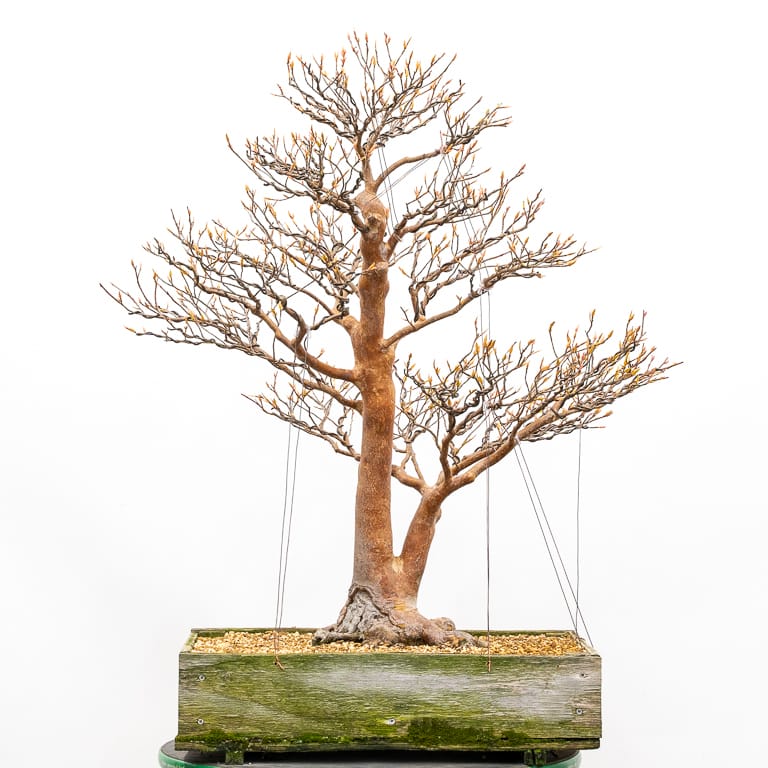
Stewartia with dieback on the trunk
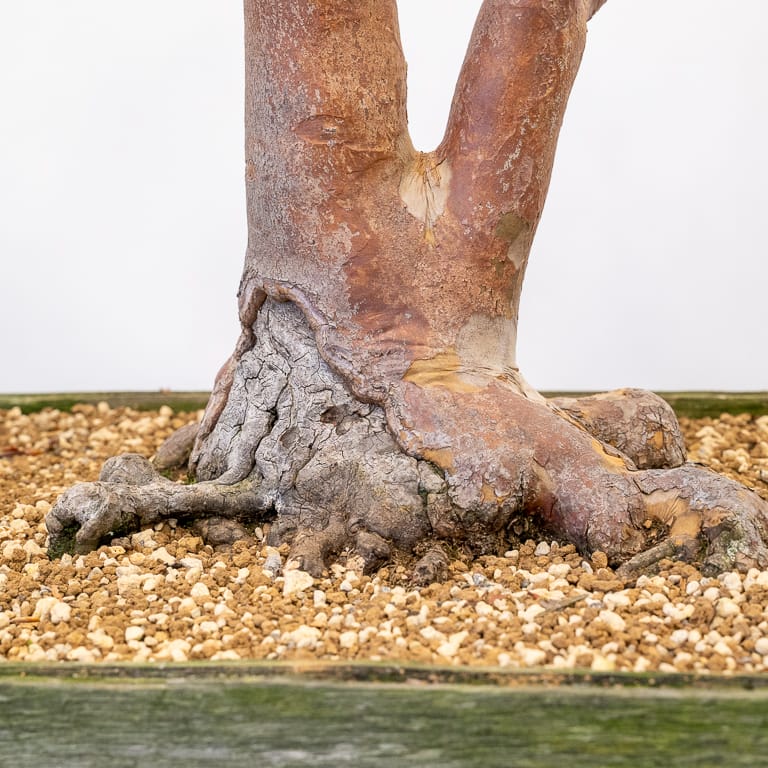
Trunk detail
There a number of options for addressing the dieback, each with their pros and cons.
The simplest option is to simply ignore the wound and show the tree as is. The great thing about this approach is that it’s easy – there’s nothing to do at all! The bad thing is that the wood will rot at some point leaving a hollow at the base of the trunk.
A related option is to purposefully create a hollow at the base of the trunk by carving. This would create visual interest to the lower trunk, but I don’t equate the species with deadwood and want to slow the decay of the wood as much as possible.
The third simple option is to hide the scar by making the back of the tree the new front.
Here’s what the back of the tree looks like.

Back side
By removing the large branch that crosses the lower part of the trunk, the tree would have an attractive form and healthy roots.
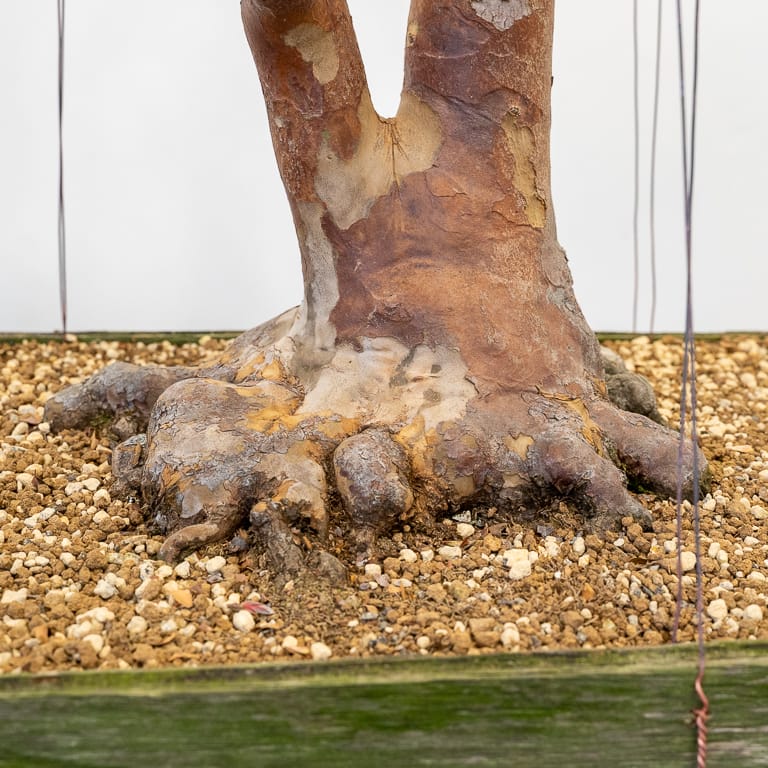
Roots on the back of the trunk
What I don’t like about this approach is that the apex would point away from the viewer. Here’s the tree from the side.
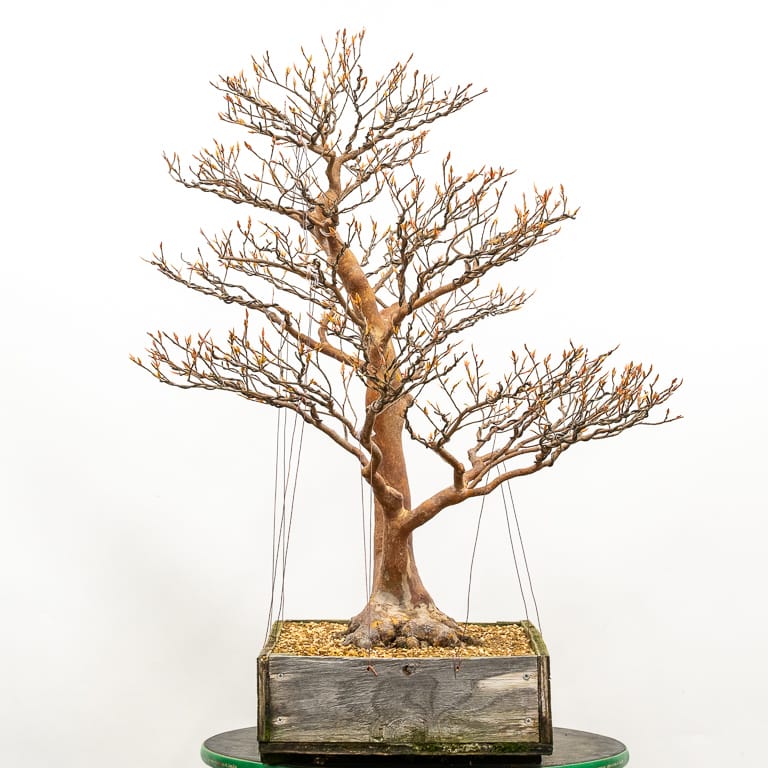
Right side
Some pruning could improve the silhouette from the side with this approach, but I’d still have the scar to deal with on the other side.
This leaves us with much slower options that involve grafting or layering.
For years, my first choice was to layer the tree just below the split.
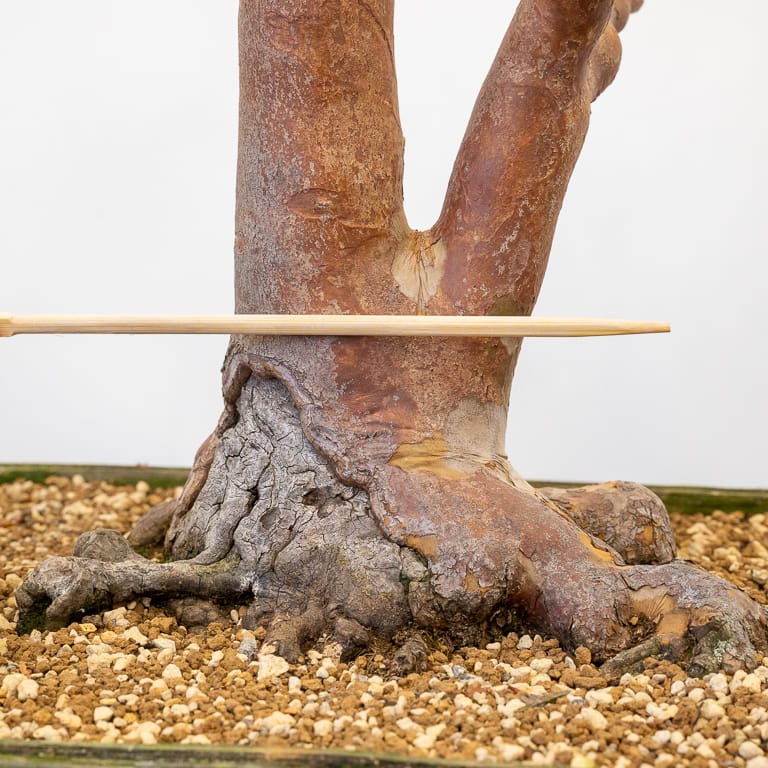
Potential air-layer line
I’ve hesitated to try this as I don’t know if I can expect roots to grow with so much dieback below a large portion of the layer.
I also thought about layering the two trunks separately and then uniting them when it was time to remove the layers. This would be a fun project but I think it would be best suited for a younger tree.
The next idea was to use approach grafts all around the trunk and then remove everything below the line where I considered layering.
Grafting is much safer than layering in that failed grafts can cause scars whereas failed layers cause dieback.
After spending two years looking for seedlings that I could use for root grafting and then pre-bending them so the roots would emerge at the correct angle from the trunk, I’ve thought about whether or not there was a way to save the base of the trunk.
Stewartia are known for producing nubby roots as they age. If I remove the base through layering or grafting, the new roots will make the tree look much younger. Root grafting can produce mature looking roots much faster than layering, but I’d still lose the large flare at the base of the trunk.
Recently I’ve been thinking about encouraging the wound to heal as fast as possible and then grafting new roots when the callus gets closer to the soil.
Here’s the point to which I’d like to see the callus form before root grafting.

Ideal spot to graft new roots.
To speed up callusing, I plan to reopen the wound in spring and apply cut paste. I’ll also select a branch or two to run for a few years as I expect callus to form more quickly when the tree is growing vigorously.
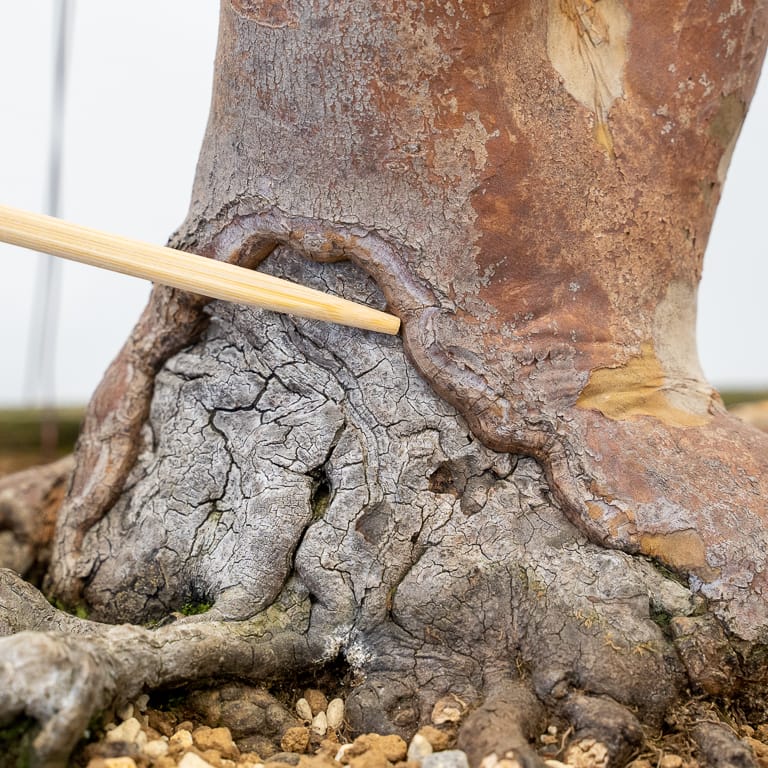
Fresh callus
That’s the plan for now anyway. If you have additional ideas, feel free to let me know in the comments below!
Subscribe to Bonsai Tonight
New Posts Delivered Every Tuesday and Friday
Thomas says
Hi Jonas,
thank you for this article and sharing your thoughts about how to solve this issue! All of your options have their pros and cons, I agree. Nevertheless, my choice would actually be the layering option.
My experience only is for acers and yews, but wherever callus will grow, so will roots. So maybe you could consider extending the callus a little deeper to the surface and then make an air layer?
Regards, Thomas
Jonas Dupuich says
Thanks for the note Thomas! I’m trying to accelerate the callus so this will be an option in a year or two. I’ve had trees completely die below layers which were successful but which ended up with uneven roots. If I had experience with layering over dead trunk and roots I’d feel better about the approach. Then I’d just need to decide if it’s worth cutting away the mature roots at the base!
Mirko says
È bellissima così è diversa
Jonas Dupuich says
Thanks, Mirko!
Dawn says
Jonas, is there a chance to do a couple thread grafts that would exit maybe at “11 and 1” at the top of the scar? I know you don’t want scars on this species, but if done at repotting the entrance wounds could be better hidden under the tree. This would allow 2 “branches” that could be allowed to run, speeding up healing without affecting the refinement of the bonsai?
Jonas Dupuich says
Great question Dawn. Using nearby branches does help the wound close faster but at the cost of creating additional wounds. A slight modification would be a bridge graft that starts at one end of the scar (9 o’clock) and reaches over to the other (3 o’clock) with the idea that the grafts will all fuse together. Another variation would be to graft all along the callus line with the roots lined up with the existing roots. Over time I could expect the trunks of the grafted seedlings to fuse and quickly close the wound.
Ryan Huston says
Nice discussion of the options Jonas! This is along the same lines I was thinking was that a few root/approach grafts placed in the middle of the deadwood up to the scar (a root would fit nicely below where your chopstick is in the last photo) would maximize the surface area of callous growing on top of the deadwood and perhaps close the wound faster.
Jonas Dupuich says
Thanks, Ryan!
Thomas says
I vote for embracing the deadwood! 🙂
Jonas, have you ever experimented with superglue treatments to harden and preserve deadwood features? I’ve seen it done in situations where lime sulfur would not be enough to preserve, or would be too bright for deciduous deadwood. Mostly I’m referencing Harry Harrington’s blog.
Seems like you know what you want to do with your tree, but I’m thinking of trying this on a few deciduous trees of mine where deadwood features are significant. I want the wood preserved, but not whitened. Just seeing if you had any thoughts.
Jonas Dupuich says
I haven’t used superglue, but I have used wood hardeners to preserve deadwood. I usually do this on conifers but expect it would work just as well for deciduous trees.
The lime sulfur isn’t a wood preservative as much as it can slow the algae that helps rot the wood. And as for its brightness, adding a drop of india ink can dull the color for trees that don’t need white wood (like ume).
Tom Pendergrass says
I can vouch that wood hardeners work very well on hollow-trunk maples
Jonas Dupuich says
Thanks, Tom!
David Crone says
Cut paste or callus mate both have hormones to stimulate growth and being at the base you would not have to worry about inverse taper. Could also try paraffin wax grafting tape. I use that grafting tape over callus mate and it healed in one season on a Japanese maples, but left a bit of inverse taper. I am going to rewound the tree and use the wax grafting tape by it’s self.
Jonas Dupuich says
Great idea David! I used tape to heal a wound on stewartia ten years ago and it worked well. The wound closed quickly but ended up flat under the tape (I’d used top jin as the paste). I may try something similar here this spring.
Steveb says
Hi Jonas
Would this work on a Japanese Black Pine? I have a JBP that has this issue. I was already thinking of re wounding the scar tissue to help heal over.
Jonas Dupuich says
Hi Steve – I don’t know that the root grafting will work, but re-opening and wound and letting a branch grow freely will definitely help with the callus production. Here’s an example of the process on a wound that’s higher on the trunk: https://bonsaitonight.com/2019/03/12/reopening-an-old-wound-to-promote-callus-formation/
Kevin Williams says
Very interesting Jonas, thanks for posting. In my mind the best approach would be to use the back as the new front. It looks pretty nice in the photo (the surface roots included). Removing the crossing branch is simple enough, and then maybe encourage the apex to lean closer to the viewer. Tilting it slightly forward in the next repot could be a good start? And then maybe some clip & grow/wiring towards the top 3rd of the tree to bring it forward some more? This all seems less risky than grafting, layering, or carving. Just some thoughts having not seen it in person.
Jonas Dupuich says
Thanks, Kevin – I think using the back is a good option for the tree, and it’s definitely less risky (which is why I’m leaning toward encouraging the wound to close). The question then would become what to do with the hollow in the back of the tree.
One option would be to use the back as the front for the next few years while the wound closes and then switch back to the other side when it looks better!
Richard Green says
This looks like a fun project. Nice tree to make even better. Looks like you’ve also thought this through well. I’ve never air layered a Stewartia, but have often read that they are very difficult to layer. This is funny, as I was just looking at an older Bonsai Today magazine last night that has a very good article in issue # 45, page17 on root grafting a Stewartia to make the tree shorter. I’m sure you’ve seen it. If not, please take a look. It might encourage you to go through with your plans.
Jonas Dupuich says
Thanks, Richard! The first thing I did was check the handful of stewarting layering articles in Bonsai Today (I’m working on an index for the series). The articles I found use trees with live tissue below the layers or grafts – what I have yet to find is an article that shows the process close when there are no roots below.
Jonathan says
Hi Jonas, great article! Which cut paste are you going to use (I assume one from your webstore)? On Ryan Neil’s Podcast, I heard Andrew Robson say he bought a certain “stronger” cut paste from your webstore to help heal a sizable wound on a Ginkgo. I’m curious to know which you’ll use as I have a Stewartia and Ginkgo I’d like to try it on.
Thanks, Jonathan
Jonas Dupuich says
Hi Jonathan – the Kirikuchi naoru is the cut paste Andrew mentioned. I’ll either use that or the “liquid cutpaste.” Stewartia normally callus well so I’d expect extra callus if I use either of these, but extra callus might be the best thing for such a large wound.
Bruno says
Hi!
I have a tree with similar situation in a smaller scale. My approach was the same as your end solution but in a different time of the year. From my research I got the info that it should be done in early fall as trees build up vascular tissue and have the ability to heal faster. I’m not sure of the best solution and I’ll be waiting to see my results but just wanted to leave this comment in case there’s a explanation of spring vs. fall. My tree is a Japanese maple and that may also play a part since it’s high water mobility and a lot of sap in spring may be lost since it’s at the trunk base.
Jonas Dupuich says
Thanks for the note Bruno! In general, I try to time the biggest wounds for early in the growing season as little happens over winter and only so much callusing can happen in the short amount of time before the trees slow down for winter. I may try re-opening the wound at different times of the year along different stretches of the callus line to see what works best for this tree!
chubby says
hollow it out and fit a cool rock into the space
Jonas Dupuich says
The rock approach looks best when the trunk begins to grow around the stone and look like it’s actually clinging to it. Were the trunk fully hollowed out, that could be a good long-term approach – with the right stone. The trick is often making the composition look like the rock was originally there.
Dan says
I like the tree the way it is. DK
Jonas Dupuich says
Thanks, Dan!
Aaron Zeng says
Beautiful tree!
The dead wood is too much for my ocd to handle. I would definitely try to fix it.
Having it as a backside wouldn’t be ideal, since it’ll just eventually rot…
For raw wood, I have tried to use epoxy(2 part product) on the surface to fill out holes, or just to re-surface the raw wood, so it doesn’t further deteriorate, while you’re healing the wound. I have found no success with traditional “wood filler”, as too much watering make it rot fast.
Jonas Dupuich says
Thanks, Aaron! I agree about the desire to cover the wound and that makes all kind of sense about epoxy vs. wood filler (which doesn’t get much use for bonsai).
Houston says
From the “back” view, it looks like the branch going up/right about 2/3 of the way up could make a new apex. Is this an option that could be considered?
Jonas Dupuich says
The back is definitely good enough to be used as a front, but I’d try and use as much as possible of the existing branches as cutting lower results in a big drop in taper that would take a long time to blend in.
Bruce Williams says
Hi Jonas,
Looks like you stimulated a great deal of thought and a number of opinions as to what direction you might take with this tree. My comment is to say what an absolutely fascinating study this will be should you decide to try to heal the “wound”. I urge you to carefully document every single step in your process. It will be a great teaching (and learning) tool
Thanks
Jonas Dupuich says
Thanks, Bruce! Will definitely share the results and the steps along the way.
Robert Thatcher says
This is a wonderful tree. How do you think about the second smaller trunk?? Is it a trunk or a branch?? To me, it is to low to be branch and would make a good second trunk. If you reverse the front / back you could tilt the trunk to the ‘new’ front to reduce the movement to the ‘new’ back. Just lower the soil level in the ‘new’ front to keep the root flair / nebari. Then a branch from the ‘second’ trunk could cross over the first trunk.
Jonas Dupuich says
Thanks, Robert! The second trunk was originally designed as more of a branch which has always been awkward. Swapping front and back is a good option, and making a subtle tilt will move the apex into place for the new front. And as for the crossing branch, it would be easy to cut without affecting the design.
daniel teixeira says
hey jonas, why dont you appreciate the deadwood and when it rots you open the hole and put some rock in when repot? so you can use roots around the roock to continue the left flare base and the callus will merge the rock with time. thats my call, if it was mine.
Jonas Dupuich says
Good question Daniel! My guess is that I don’t appreciate deadwood on bonsai as I don’t see a lot of it on my favorite deciduous trees here or in Japan. As for inserting a stone, I like the look of trees that have spent their whole lives on the stone – a look that I find hard to recreate after the fact.